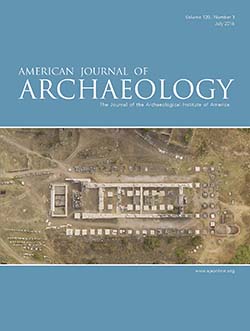AJA Open Access
BY-NCJuly 2016 (120.3)
Book Review
Failaka/Dilmun: The Second Millennium Settlements. Vol. 4, The Stone Vessels
By Anna Hilton
Reviewed by Danny Rosenberg
Publication of finds from old excavations is always welcome, although this sometimes poses difficulties with regard to context and chronology. The book under review is no exception. Volume 4 of the Danish Archaeological Investigation on Failaka, Kuwait, deals with the stone vessels of the third- and second-millennium B.C.E. settlements on Failaka and provides a coherent descriptive account of an unusual assemblage of meticulously made stone bowls. The assemblage was recovered during the excavations by the Danish Archaeological Expedition from 1958 to 1963 at three tells (F3, F5, and F6) on the Island of Failaka.
The volume is arranged in five chapters plus an appendix that provides basic data concerning the 387 vessels discussed. Much of the book is a catalogue that presents the vessel fragments with a short introductory essay on each vessel style. Chapter 1 includes a short introduction to the site and the history of the large assemblage. Chapter 2 presents the classification used for the assemblage, including rock determinations, vessel shapes, and decoration. Chapter 3 provides an account of the eight vessel styles that are based on the typological analyses of the stone, morphology, and decoration. Five of these styles were already recognized in the past, while three new styles are presented here. Chapter 4 discusses secondary use of vessels modified into other artifacts, such as pendants and spindle whorls, and chapter 5 offers concise conclusions for the entire study.
Research on ground stone artifacts in general, and studies on stone vessels in particular, still suffer from a lack of clear and coherent research methodology and a thorough theoretical framework. In part, this may have been the result of the problematic definitions of these objects and the lack of systematic typologies, methodologies, and conventions. As Hilton notes in the beginning of chapter 2, relatively little has been published on stone vessel classification (esp. as compared to classification of ceramic vessels). Having said that, the author seems to ignore available data from the Near East and elsewhere that specifically deal with classification of stone vessels and include various approaches and methodologies.
Also notable is the study’s unfortunate heavy reliance on general identification of rock types (color, composition, and structure of the rock matrix). We could have learned much more if simple petrographic analysis, or any other analytical method that is in use today for rock identification (e.g., XRD, XRF), had been implemented at least on representative items from the assemblage (although a previous study that includes such analyses is mentioned briefly). Thus, although the classification into rock types is important, the methodology used for the definition of the 11 types raises some questions. Since the author mentions that none of the rock types are available on the Failaka Island or in mainland Kuwait, the lack of discussion on this point is regrettable.
The morphological classification used is important and includes all 387 diagnostic stone vessel fragments. Section 2.2 presents a thorough description of the defined morphological types, although unfortunately it seems to bring together different levels of classification (vessel parts as well as variants within each) with no clear hierarchical subdivision. Section 2.3 is also very informative, and the presence of two fundamentally different decoration styles (figurative and geometric) is notable, as is the presence of cuneiform inscriptions on 13 vessels.
It is very helpful that the author provides photographs and drawings of the vessels (in ch. 3), as the reader can retrieve much, almost first-hand, information from the images (although personally I prefer a scale bar on each page containing images or drawings to help the reader understand the size of the vessels more easily). This is a useful approach, which might have been improved if supplemented with the vessel data in the same location (under the images).
Bearing in mind the problems involved in securely dating some of the vessels and identifying their contexts, the conclusion of the volume might have benefited from a more in-depth discussion on a number of topics, such as provenance, production and finishing, wear, morphological patterning, and discard patterns. Beyond that, however, the chronological discussion is important and supplies the reader with insights concerning the possible attribution of the different vessel styles defined in the study.
In conclusion, despite the few methodological issues and other points discussed above, the volume is an important contribution to the study of stone vessels from the Persian Gulf during the second and third millennia B.C.E. and brings an important corpus of these objects to public awareness. While Hilton’s book will obviously not be the last to be written on this truly impressive group of vessels, it helps establish coherent and reliable data sets concerning stone vessels and other stone implements from this area, which have been largely neglected.
Danny Rosenberg
Laboratory for Ground Stone Tools Research
Zinman Institute of Archaeology
University of Haifa
drosenberg@research.haifa.ac.il
